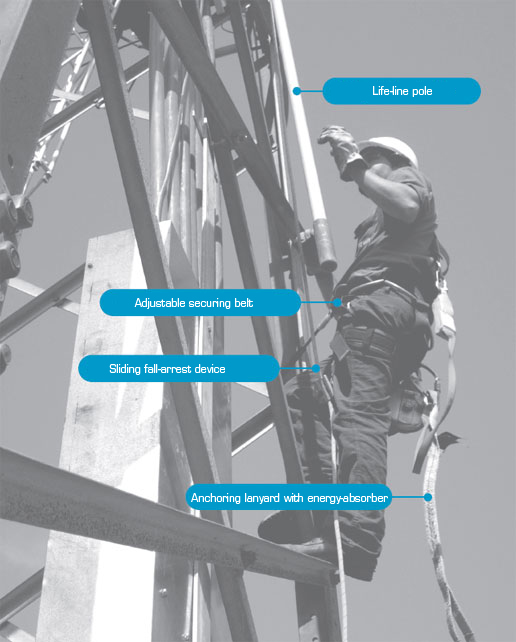Working at Heights
7. Ascending and Descending Pylons
7.2. Descent
To descend, carry out the aforementioned operations in the inverse order.
For higher pylons with thicker structural angles, it is advisable to use the Y-shaped double anchoring system.
7.3. Horizontal displacement on the pylon structure
Once you have ascended to the support position, it is often necessary to go outside the crossbars to work with chains and conductors.
For this displacement, you are to use a 10-m semistatic lanyard (which forms part of your personal equipment) as the safety rope.
To use this correctly, the following has to be taken into account:
To be able to release yourself from the vertical rope and be protected by an anti-fall system, the first operation will be to attach a fall-arrest lanyard to a structural angle above your head and then secure yourself to the structure using an adjustable anchoring element, as explained in the section on repositioning the pole.
Next, anchor the 10-m lanyard to an upright of the pylon using a belt ring and carabiner.
The sliding fall-arrest device that is attached to the harness and to the vertical rope is released from the latter and is attached to the lanyard. Depending on the length of the crossbar, it will be necessary to install one or more belt rings as intermediate support for the lanyard.
Displacement along the crossbar and even on ladders, whether these are suspended or anchored, is to be ensured by the anti-fall system composed of the harness, semistatic lanyard and the sliding fall-arrest device (“self-gripping clamp”).
When there is no need to carry out horizontal displacements, it is necessary to bear in mind the pendulum effect: as you go further out from the vertical of the suspension point, the possibilities of hitting the structure increase in the case of falling.
When moving horizontally, it is important to move the branch of the lanyard so as to avoid it getting tangled up with the rope. The arrow on the branch must point to the anchor point of the lanyard.





